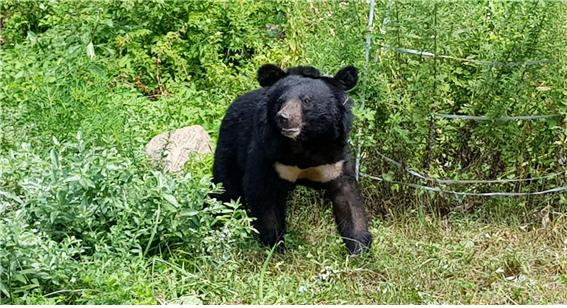 |
A moon bear, also known as the Asiatic black bear, in a breeding facility managed by the Korean National Park Service. (KNPS) |
Korea’s ancient founding myth features two predatory animals, a tiger and a bear, both of which once freely roamed the hilly terrains of the Korean Peninsula.
By the late 1990s, however, both species had become extinct or nearly extinct in the wild, while hikers and trekkers came to replace them as rulers of the mountains.
In 2004, a government-led restoration effort was launched for Korean moon bears, starting with the introduction of six Asiatic black bears from Primorsky Krai, Russia. These bears share the same genetic lineage as those that once lived in Korea.
Two decades later, in 2024, the Korean National Park Service reports that a total of 86 wild bears now inhabit Jirisan, far exceeding the initial target of 50. This number includes seven baby bears that were born in the winter of 2022.
However, as the bear population continues to grow, their habitat has expanded far beyond the manmade territorial boundaries, spreading throughout the mountain range. This has increased the possibility of encounters between the animals and hikers or residents of hillside villages, stoking fears among some.
‘Humans should learn to live with bears again’
Animal rights groups and advocates of the bear restoration project say it is now time for Koreans to learn to live with bears, challenging the prevailing notion that the bears must be monitored and managed so that they don’t pose any threat to human environments.
“The goal of reintroducing bears was not to confine them within specific areas of Jirisan. Rather, it was to reestablish an ecosystem where the animals can freely wander across the mountain ranges like in the past,” said Yoon Ju-ok, an animal rights activist, in an interview with local media. Yoon penned a book on Osam, a bear also known as the K-53, which died last year during an attempt to capture it after it had left Jirisan.
She stressed that wild bears cannot be controlled, nor they should be, and that we must accept them as they are. “It is time that we consider how we can coexist peacefully with the bears.”
Although there have been countless reports of bear sightings, there has not been a single incidence of the animals attacking humans.
An analysis by the Korean National Park Service of the released bears’ activities and routes reveals that they avoid areas where human encounters are likely, namely trekking trails and villages.
The park service advises mountain visitors to stick to well-established trails and not to venture deep into the forest. In case of an encounter, visitors should not feed the bears or take photographs. Instead, they are advised to slowly back away from the area while maintaining eye contact.
The authority recommends the use of a bell while hiking to alert bears of a hiker's presence, as well as carrying bear spray to protect themselves in case of an attack.
The bears, as the apex predators, play a crucial role in stabilizing the plant ecosystem. They primarily feed on acorns and fruits, although they also hunt small animals such as rodents.
According to the Cultural Heritage Administration, germination experiments on seeds extracted from Asiatic black bear feces, compared to regular seeds, revealed that bear-dispersed seeds had a germination rate two to three times higher.
As bears move and excrete seeds, their germination contributes to richer vegetation, thereby creating habitats for insects and other wildlife.
‘An uncontrollable risk’
Bears are wild animals, and in Japan, many villagers and hikers have been attacked by them. This is why critics say Korea’s bear restoration project has become overly romanticized.
Lee Sung-taek, 39, an avid hiker, expressed real concern about potential bear encounters and is now considering carrying bear spray for protection.
“Although moon bears primarily eat plants, they can become aggressive and attack humans, especially under stress or provocation,” he said.
He cited incidents of bear attacks at illegal farms as proof of the threat the animals pose to humans. In 2022, a couple in their sixties were killed by bears that they kept at their farm in Ulsan.
In Japan, a record-high number of 193 bear attacks were reported last year, prompting heightened vigilance in the affected areas. A total of 212 people were injured in these attacks, while six people were killed. The figures marked the highest tally since counting began in 2006.
Alarmed by the uptick in bear attacks, Japan earlier this month announced measures to control the bear population in the country, including the introduction of incentives for hunting.
In Korea, since the initiation of the restoration project, there have been approximately 560 cases of state compensation for damage caused by wild bears.
Most of the incidents involved bears venturing close to residential areas in search of good food or honey from beekeeping farms. But in Sangju last year, bears believed to come from Jirisan killed three goats at a farm in the lowlands.







![[Weekender] Korea's traditional sauce culture gains global recognition](http://res.heraldm.com/phpwas/restmb_idxmake.php?idx=644&simg=/content/image/2024/11/21/20241121050153_0.jpg)